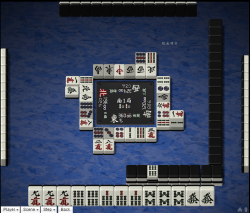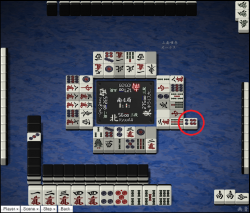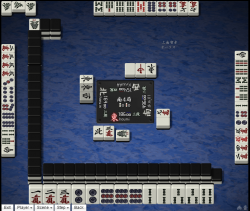Furiten: Difference between revisions
mNo edit summary |
|||
| (74 intermediate revisions by 11 users not shown) | |||
| Line 1: | Line 1: | ||
[[Image:Furiten.png|right|thumb|250px|[http://tenhou.net/0/?log=2012110112gm-0009-7447-14ec5c8d&tw=0&ts=4 Baiman tenpai], in furiten due to 9-sou in discard. Ron cannot be called here.]] | [[Image:Furiten.png|right|thumb|250px|[http://tenhou.net/0/?log=2012110112gm-0009-7447-14ec5c8d&tw=0&ts=4 Baiman tenpai], in furiten due to 9-sou in discard. Ron cannot be called here.]] | ||
''' | While a player's hand is in '''furiten''' {{kana|振聴}}, they cannot declare a win on another player's [[ron|discard]] (i.e., they cannot [[ron]]). They are still allowed to win with their own draw ([[tsumo]]), assuming the hand is valid. | ||
The most common way to enter furiten is from discards: if a player had previously discarded a tile that their hand could now win with, their hand is considered furiten. Furiten is also caused when a player skips a win. | |||
This rule is often used for [[defense]]: any tile a player discards is [[genbutsu|100% safe]] against that player. | |||
== | == Rule overview == | ||
[[Image:Furiten ron MLeague.png|right|250px|thumb|Furiten ron with a 5-sided wait in [[M.League]] invoking [[chombo]].<ref>[https://www.youtube.com/watch?v=RQ102K4Kl8w&t=260 Furiten-ron chombo] (M.League 24-25, Sep.27 #2, South 2 Round 1 honba, North seat)</ref>]] | |||
While the hand is in furiten, the player is unable to call ron off any tile, but they can win by [[tsumo]] ''if'' the hand has valid [[yaku]]. | |||
A hand in [[tenpai]] is in furiten in any of the following scenarios: | |||
* When at least one of the hand's current winning tiles have been discarded by you before, the hand enters furiten. | |||
** A tile does not have to be physically in your discard pile to invoke furiten. If an opponent [[naki|called]] on your discarded tile, said tile will still trigger furiten. | |||
* After declaring [[riichi]], if the first winning tile is skipped, the hand permanently enters furiten. | |||
* When not in riichi, when a winning tile is skipped, the hand enters temporary furiten. This furiten lasts until the player's next discard. | |||
A "winning tile" is any tile that could complete a "4 groups + 1 pair" winning shape (or [[chiitoitsu]] / [[kokushi musou]]), ''even if the hand could not actually win because it would lack yaku''. | |||
Note that, when in furiten, the hand is unable to win off ''any'' discard; the tile that "caused" furiten is irrelevant. For example, if your hand is waiting to win with 2p and 5p, and you had discarded 2p before, you are unable to win off an opponent's 5p. | |||
=== Discard furiten === | |||
Discard furiten, the most common form of furiten, occurs when a player's own winning tile has been discarded before. A hand can escape this type of furiten by changing its waits. | |||
Because discard furiten exists, any tile a player has discarded is 100% safe against that player. Even if the player is waiting on that tile, they cannot ron (as they'd be in furiten). | |||
It is important to bear furiten in mind when developing a hand. If a hand gets to tenpai and is furiten, it may have been inefficiently developed. This is not always the case, however, as a player can make a correct decision but still be in furiten. | |||
A hand with no guaranteed yaku - a state known as [[atozuke]] - is particularly susceptible to furiten. When a hand is in atozuke, only some winning tiles would result in having a yaku. If a non-yaku winning tile is obtained, the hand is unable to win, and forced to enter discard furiten. Atozuke often occurs with: | |||
*A [[shanpon]] wait, with one tile completing a [[yakuhai]] triplet, and the other having no yaku. | |||
*A [[ryanmen]] wait on 14 or 69 on a hand that would otherwise complete [[tanyao]]. | |||
=== Temporary furiten === | |||
[[Image:TempFuriten.png|thumb|right|250px|Ron declined, so [http://tenhou.net/0/?log=2014022617gm-0089-0000-ee8c6631&tw=2&ts=11 temporary furiten invoked] until the next own's tile draw.]] | |||
Calling a win is optional. If a non-[[riichi]] player does not ron a "winning tile" (even if said tile can't win due to lack of yaku), they enter temporary furiten until their next discard. Since it lasts for 1 turn, it is called temporary furiten. | |||
Sometimes, a player may misinterpret their waits, entering furiten in the process. Alternatively, a player may be in atozuke and a non-yaku giving tile is discarded. Otherwise, a player may intentionally skip a win, entering temporary furiten in the process. This is mainly done after [[situational analysis|point standing analysis]], such as: | |||
*When a player is close to [[tobi|bankrupting]], a player in 1st may want to target them in order to end the game faster. | |||
*When close to [[oorasu|all last]], a player may need to ron a specific player to [[gyakuten|rise up in rank]]. | |||
In a few [[Rule variations#Furiten|rulesets]], any tile call will cancel other players' temporary furiten. | |||
=== Permanent furiten during riichi === | |||
[[Image:Furiten riichi.png|250px|thumb|right|[http://tenhou.net/0/?log=2015082022gm-0089-0000-a1177c83&tw=1&ts=11 Furiten riichi] applied upon declaration and discard declining a winning hand.]] | |||
{{main|Riichi}} | |||
When a player has declared riichi, the state of temporary furiten does not expire. Therefore, if a riichi hand skips a win, it is no longer able to call ron. This is known as permanent furiten, or riichi furiten. | |||
Since riichi is a yaku, there is no need to worry about a lack of yaku, unless under [[ryanhan shibari]]. | |||
== Reasoning == | |||
Furiten exists for two main reasons: | |||
1. It helps players [[defense|defend]] against other player's hands: | |||
* Discard furiten: Any tile a player has discarded before is 100% safe against that player. | |||
* Temporary furiten: The tile the player on your left discards is 100% against all players that turn. The tile the player across from you discards is 100% safe against the rightmost player. | |||
* Permanent furiten: After a player declares riichi, any tile anyone discards is safe against that riichi player. | |||
2. It makes it much harder to target other players. | |||
* Because discard furiten exists, players cannot skip a tsumo win in order to ron another player. | |||
* Because temporary and permanent furiten exist, players must take the first ron or enter some form of furiten. Since a non-riichi hand ''could'' change its waits every turn, temporary furiten only lasts 1 turn. Because a riichi hand cannot change its waits, permanent furiten lasts until the end of the hand. | |||
== Example == | |||
{{Discard pile | {{Discard pile | ||
|align = right | |align = right | ||
| Line 25: | Line 74: | ||
}} | }} | ||
:{{machi | |||
|pattern = 77m34567p678s777z | |||
|tilewaits = 258p | |||
}} | |||
This hand waits on three different tiles. If the player has a 2-pin in their discard pile, then the hand is in furiten and may not win by ron on any tile. Even if a 5-pin or 8-pin gets discarded by an opponent, ron may not be called. | |||
== Strategy == | |||
=== Defense === | |||
{{main|Defense}} | |||
=== | |||
{{main| | |||
The furiten rule is essential for defensive play. As mentioned in the [[#Reasoning|Reasoning]] section, any tile that would invoke furiten to a player is 100% safe against that player: | |||
*Discard furiten: Any tile that an opponent discarded is 100% against them. | |||
*Permanent furiten: After an opponent declares [[riichi]], any tile anyone discards is 100% safe against that riichi player. | |||
*Temporary furiten: Any tile that the player to your left has discarded this turn is 100% safe against every player for this turn only. | |||
[[Suji]] is a technique that is related to furiten. When a tile is suji, a hand cannot have a [[ryanmen]] wait (2-sided wait; the most common type of wait) for that tile without being in furiten. | |||
=== | ===Working with furiten=== | ||
Sometimes, it may be necessary to enter tenpai when it would be furiten. Often, this is the result of developing the hand and defending simultaneously. | |||
An important thing to realize is that you only enter furiten when in tenpai. Therefore, it is not the worst thing to keep a wait that could cause furiten later. So long as you complete the wait before tenpai, there is no punishment. | |||
Even if you do enter furiten, a 3-sided wait in furiten is still strong, and a 2-sided wait in furiten remains reasonable (around the level of a 1-sided wait). | |||
Rarely, a hand in [[damaten]] can intentionally enter furiten. In this case, the hand is in tenpai, but after a winning tile is drawn, the player declares riichi instead of a win - immediately entering furiten. This may be done to score a yaku like [[pinfu]] or [[sanshoku]]. | |||
=== | ===Exiting furiten=== | ||
To exit discard furiten, you can change the hand's [[wait]] so that it can no longer win off any of the discarded tiles. For example: | |||
:{{#mjt:22288m23p3456'78s}} Draw: {{#mjt:3p}} Waiting for: {{#mjt:14p}} (furiten) | |||
If the hand had discarded {{#mjt:1p}} previously, it would be in furiten. By drawing {{#mjt:3p}} and discarding {{#mjt:2p}}, it now waits on {{#mjt:3p}} and {{#mjt:8m}}. Thus, the hand is no longer waiting on {{#mjt:1p}}, and is no longer in furiten. | |||
== References == | |||
<references/> | |||
== External links == | == External links == | ||
Latest revision as of 07:25, 20 November 2024

While a player's hand is in furiten 「振聴」, they cannot declare a win on another player's discard (i.e., they cannot ron). They are still allowed to win with their own draw (tsumo), assuming the hand is valid.
The most common way to enter furiten is from discards: if a player had previously discarded a tile that their hand could now win with, their hand is considered furiten. Furiten is also caused when a player skips a win.
This rule is often used for defense: any tile a player discards is 100% safe against that player.
Rule overview

While the hand is in furiten, the player is unable to call ron off any tile, but they can win by tsumo if the hand has valid yaku.
A hand in tenpai is in furiten in any of the following scenarios:
- When at least one of the hand's current winning tiles have been discarded by you before, the hand enters furiten.
- A tile does not have to be physically in your discard pile to invoke furiten. If an opponent called on your discarded tile, said tile will still trigger furiten.
- After declaring riichi, if the first winning tile is skipped, the hand permanently enters furiten.
- When not in riichi, when a winning tile is skipped, the hand enters temporary furiten. This furiten lasts until the player's next discard.
A "winning tile" is any tile that could complete a "4 groups + 1 pair" winning shape (or chiitoitsu / kokushi musou), even if the hand could not actually win because it would lack yaku.
Note that, when in furiten, the hand is unable to win off any discard; the tile that "caused" furiten is irrelevant. For example, if your hand is waiting to win with 2p and 5p, and you had discarded 2p before, you are unable to win off an opponent's 5p.
Discard furiten
Discard furiten, the most common form of furiten, occurs when a player's own winning tile has been discarded before. A hand can escape this type of furiten by changing its waits.
Because discard furiten exists, any tile a player has discarded is 100% safe against that player. Even if the player is waiting on that tile, they cannot ron (as they'd be in furiten).
It is important to bear furiten in mind when developing a hand. If a hand gets to tenpai and is furiten, it may have been inefficiently developed. This is not always the case, however, as a player can make a correct decision but still be in furiten.
A hand with no guaranteed yaku - a state known as atozuke - is particularly susceptible to furiten. When a hand is in atozuke, only some winning tiles would result in having a yaku. If a non-yaku winning tile is obtained, the hand is unable to win, and forced to enter discard furiten. Atozuke often occurs with:
- A shanpon wait, with one tile completing a yakuhai triplet, and the other having no yaku.
- A ryanmen wait on 14 or 69 on a hand that would otherwise complete tanyao.
Temporary furiten

Calling a win is optional. If a non-riichi player does not ron a "winning tile" (even if said tile can't win due to lack of yaku), they enter temporary furiten until their next discard. Since it lasts for 1 turn, it is called temporary furiten.
Sometimes, a player may misinterpret their waits, entering furiten in the process. Alternatively, a player may be in atozuke and a non-yaku giving tile is discarded. Otherwise, a player may intentionally skip a win, entering temporary furiten in the process. This is mainly done after point standing analysis, such as:
- When a player is close to bankrupting, a player in 1st may want to target them in order to end the game faster.
- When close to all last, a player may need to ron a specific player to rise up in rank.
In a few rulesets, any tile call will cancel other players' temporary furiten.
Permanent furiten during riichi

When a player has declared riichi, the state of temporary furiten does not expire. Therefore, if a riichi hand skips a win, it is no longer able to call ron. This is known as permanent furiten, or riichi furiten.
Since riichi is a yaku, there is no need to worry about a lack of yaku, unless under ryanhan shibari.
Reasoning
Furiten exists for two main reasons:
1. It helps players defend against other player's hands:
- Discard furiten: Any tile a player has discarded before is 100% safe against that player.
- Temporary furiten: The tile the player on your left discards is 100% against all players that turn. The tile the player across from you discards is 100% safe against the rightmost player.
- Permanent furiten: After a player declares riichi, any tile anyone discards is safe against that riichi player.
2. It makes it much harder to target other players.
- Because discard furiten exists, players cannot skip a tsumo win in order to ron another player.
- Because temporary and permanent furiten exist, players must take the first ron or enter some form of furiten. Since a non-riichi hand could change its waits every turn, temporary furiten only lasts 1 turn. Because a riichi hand cannot change its waits, permanent furiten lasts until the end of the hand.
Example
This hand waits on three different tiles. If the player has a 2-pin in their discard pile, then the hand is in furiten and may not win by ron on any tile. Even if a 5-pin or 8-pin gets discarded by an opponent, ron may not be called.
Strategy
Defense
The furiten rule is essential for defensive play. As mentioned in the Reasoning section, any tile that would invoke furiten to a player is 100% safe against that player:
- Discard furiten: Any tile that an opponent discarded is 100% against them.
- Permanent furiten: After an opponent declares riichi, any tile anyone discards is 100% safe against that riichi player.
- Temporary furiten: Any tile that the player to your left has discarded this turn is 100% safe against every player for this turn only.
Suji is a technique that is related to furiten. When a tile is suji, a hand cannot have a ryanmen wait (2-sided wait; the most common type of wait) for that tile without being in furiten.
Working with furiten
Sometimes, it may be necessary to enter tenpai when it would be furiten. Often, this is the result of developing the hand and defending simultaneously.
An important thing to realize is that you only enter furiten when in tenpai. Therefore, it is not the worst thing to keep a wait that could cause furiten later. So long as you complete the wait before tenpai, there is no punishment.
Even if you do enter furiten, a 3-sided wait in furiten is still strong, and a 2-sided wait in furiten remains reasonable (around the level of a 1-sided wait).
Rarely, a hand in damaten can intentionally enter furiten. In this case, the hand is in tenpai, but after a winning tile is drawn, the player declares riichi instead of a win - immediately entering furiten. This may be done to score a yaku like pinfu or sanshoku.
Exiting furiten
To exit discard furiten, you can change the hand's wait so that it can no longer win off any of the discarded tiles. For example:
If the hand had discarded ![]() previously, it would be in furiten. By drawing
previously, it would be in furiten. By drawing ![]() and discarding
and discarding ![]() , it now waits on
, it now waits on ![]() and
and ![]() . Thus, the hand is no longer waiting on
. Thus, the hand is no longer waiting on ![]() , and is no longer in furiten.
, and is no longer in furiten.
References
- ↑ Furiten-ron chombo (M.League 24-25, Sep.27 #2, South 2 Round 1 honba, North seat)
External links
- Furiten in Japanese Wikipedia